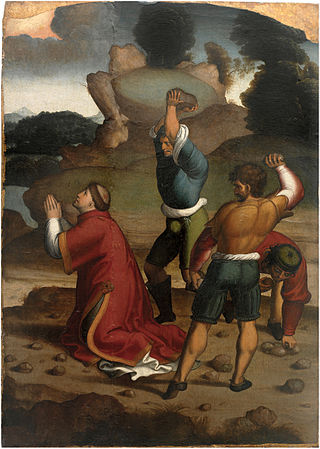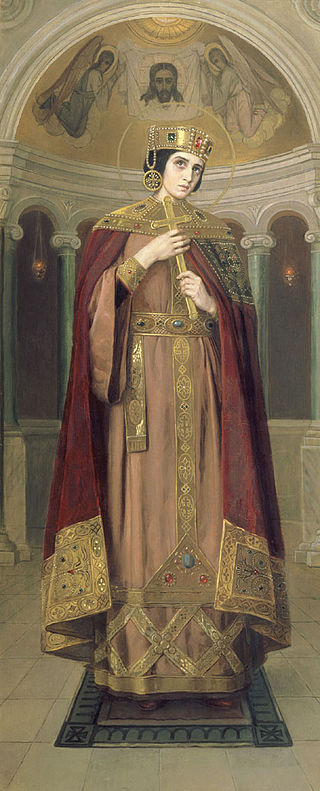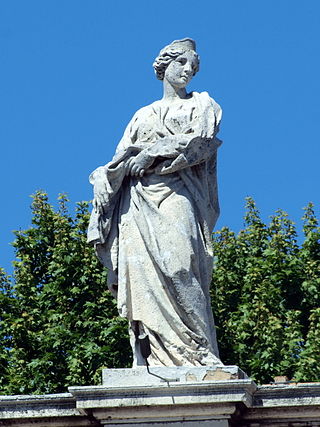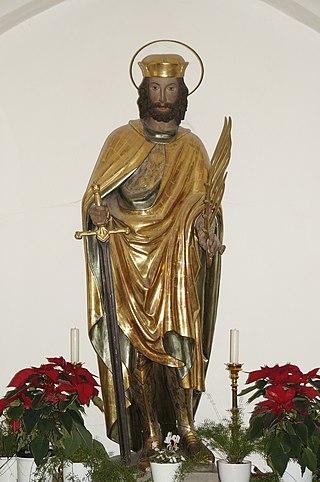Biography
According to an early account by St. Justin Martyr, Ptolemaeus converted a promiscuous woman to Christianity, teaching her to live in chastity. [1] The woman left her husband. Ptolemaeus was then accused by the woman's husband of engaging in improper behavior with her. Ptolemaeus was brought before the prefect Lollius Urbic(i)us at Rome and was thrown into prison. He was later executed.
Lucius was a man who protested against Ptolemaeus' sentence. He argued that Ptolemaeus has not been found guilty of any crime, and argued that Ptolemaeus was innocent of the charges brought against him (adultery, sexual immorality, murder, clothes stealing, robbery), challenging the honor of the prefect, the emperor, and the Senate. [2] Lucius dangerously maintained that the sentence that had been imposed was unworthy of all of them. Lucius was then executed. Justin writes about a third, unnamed martyr: "Next, a third man also deserted [i.e. disagreed with the sentence] and was sentenced to be punished." [2] Justin's description of the martyrdom of these three people in his Second Apology is one of the oldest authentic reports of martyrdom at Rome. [3]

Justin, known posthumously as Justin Martyr, also known as Justin the Philosopher, was an early Christian apologist and philosopher.

Agnes of Rome is a virgin martyr, venerated as a saint in the Catholic Church, Oriental Orthodox Church and the Eastern Orthodox Church, as well as the Anglican Communion and Lutheran Churches. She is one of several virgin martyrs commemorated by name in the Canon of the Mass, and one of many Christians martyred during the reign of the Roman emperor Diocletian.

Pope Lucius I was the bishop of Rome from 25 June 253 to his death on 5 March 254. He was banished soon after his consecration, but gained permission to return. He was mistakenly classified as a martyr in the persecution by Emperor Valerian, which did not begin until after Lucius' death.

A martyr is someone who suffers persecution and death for advocating, renouncing, or refusing to renounce or advocate, a religious belief or other cause as demanded by an external party. In colloquial usage, the term can also refer to any person who suffers a significant consequence in protest or support of a cause.

Saint Lawrence or Laurence was one of the seven deacons of the city of Rome under Pope Sixtus II who were martyred in the persecution of the Christians that the Roman emperor Valerian ordered in 258.

In Christianity, a martyr is a person who was killed for their testimony for Jesus or faith in Jesus. In the years of the early church, stories depict this often occurring through death by sawing, stoning, crucifixion, burning at the stake, or other forms of torture and capital punishment. The word martyr comes from the Koine word μάρτυς, mártys, which means "witness" or "testimony".

Quintus Lollius Urbicus was a Berber governor of Roman Britain between the years 139 and 142, during the reign of the Emperor Antoninus Pius. He is named in the Historia Augusta, although it is not entirely historical, and his name appears on five Roman inscriptions from Britain; his career is set out in detail on a pair of inscriptions set up in his native Tiddis near Cirta, Numidia.
Saints Theodora and Didymus are Christian saints whose legend is based on a 4th-century acta and the word of Saint Ambrose. The pair were martyred in the reigns of co-ruling Roman Emperors Diocletian and Maximianus. St. Theodora should not be confused with another St. Theodora of Alexandria commemorated on September 11.

October 18 - Eastern Orthodox liturgical calendar - October 20

Alexandra of Rome was a Christian martyr and saint, known from Martyrdom of Saint George as either Emperor Diocletian's wife or the wife of Dacian, a Roman Prefect. She is also sometimes mistaken with Priscilla or Prisca.

Mark and Marcellian are martyrs venerated as saints by the Roman Catholic Church and the Eastern Orthodox Church. Their cult is sometimes associated with that of Saints Tranquillinus, Martia, Nicostratus, Zoe, Castulus, and Tiburtius, though not in the official liturgical books of the Church, which mention only Mark and Marcellianus among the saints for 18 June. Their mention in the General Roman Calendar on that date from before the time of the Tridentine calendar was removed in the 1969 revision, because nothing is known about them except their names, the fact of their martyrdom, and that they were buried on 18 June in the cemetery of Santa Balbina on the Via Ardeatina.

Justina of Padua is a Christian saint and a patroness of the city of Padua. Her feast day is October 7. She was devoted to religion from her earliest years and took the vow of perpetual virginity. When she was brought before Maximian the prefect, she remained firm against all attacks. The prefect caused her to be slain with the sword.

The mythical Balbina of Rome, sometimes called Saint Balbina and Balbina the Virgin has been venerated as a virgin martyr and saint of the Catholic Church. As is made clear in the Catholic Encyclopaedia, it seems what follows has been nothing more than fable, not history.

Felicitas of Rome, also anglicized as Felicity, is a saint numbered among the Christian martyrs. Apart from her name, the only thing known for certain about this martyr is that she was buried in the Cemetery of Maximus, on the Via Salaria on a 23 November. However, a legend presents her as the mother of the seven martyrs whose feast is celebrated on 10 July. The Eastern Orthodox Church celebrates their martyrdom on 25 January.

Saint Sabina is a saint of the early church, believed to have lived and suffered martyrdom at the beginning of the 2nd century in Rome. Her feast day is 29 August.

Christians were persecuted throughout the Roman Empire, beginning in the 1st century AD and ending in the 4th century. Originally a polytheistic empire in the traditions of Roman paganism and the Hellenistic religion, as Christianity spread through the empire, it came into ideological conflict with the imperial cult of ancient Rome. Pagan practices such as making sacrifices to the deified emperors or other gods were abhorrent to Christians as their beliefs prohibited idolatry. The state and other members of civic society punished Christians for treason, various rumored crimes, illegal assembly, and for introducing an alien cult that led to Roman apostasy. The first, localized Neronian persecution occurred under Emperor Nero in Rome. A number of mostly localized persecutions occurred during the reign of Marcus Aurelius. After a lull, persecution resumed under Emperors Decius and Trebonianus Gallus. The Decian persecution was particularly extensive. The persecution of Emperor Valerian ceased with his notable capture by the Sasanian Empire's Shapur I at the Battle of Edessa during the Roman–Persian Wars. His successor, Gallienus, halted the persecutions.

Castulus is venerated as a martyr and saint. According to tradition, he was the chamberlain of Emperor Diocletian and the husband of Irene of Rome.

The Myth of Persecution: How Early Christians Invented a Story of Martyrdom is a 2013 book by Candida Moss, an award-winning historian and professor of New Testament and Early Christianity at the University of Notre Dame. Prior to the writing of this book Moss had published two other works on early Christian martyrdom. In her book, Moss advances the thesis that:
- The traditional idea of the "Age of Martyrdom", when Christians suffered persecution from the Roman authorities and lived in fear of being thrown to the lions, is largely fictional. Here she adapts and emends the work of G. E. M. de Ste. Croix.
- There was never sustained, targeted persecution of Christians by Imperial Roman authorities. Official persecution of Christians by order of the Roman Emperor lasted for at most twelve years of the first three hundred of the Church's history. Moss writes: "This does not mean, however, that there were no martyrs at all or that Christians never died. It is clear that some people were cruelly tortured and brutally executed for reasons that strike us as profoundly unjust."
- Most of the stories of individual martyrs amassed by the early modern period are pure inventions. She agrees with Bollandist scholar Hippolyte Delehaye that most martyrdom literature developed in the fourth century and beyond.
- Even the oldest and most historically accurate stories of martyrs and their sufferings have been altered and re-written by later editors, so that it is impossible to know for sure what any of the martyrs actually thought, did or said.

Perpetua and Felicity were Christian martyrs of the third century. Vibia Perpetua was a recently married, well-educated noblewoman, said to have been 22 years old at the time of her death, and mother of an infant son she was nursing. Felicity, a slave woman imprisoned with her and pregnant at the time, was martyred with her. They were put to death along with others at Carthage in the Roman province of Africa.

The Martyrs of Carthage under Valerian were a group of Christians including Montanus, Lucius, Flavian, Julian, Victoricus, Primolus, Rhenus, and Donatian. All were executed during the persecutions of the Roman Emperor Valerian in 259 AD. Their feast day is 24 February.


















